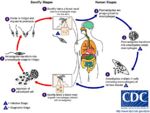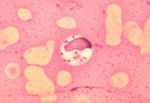|
|
| Line 103: |
Line 103: |
| | **[[Psychodidae|Sand flies]] biting infected dogs may spread the disease to other dogs, humans and wildlife | | **[[Psychodidae|Sand flies]] biting infected dogs may spread the disease to other dogs, humans and wildlife |
| | **There is a slight possibility of transmission to humans by direct contact | | **There is a slight possibility of transmission to humans by direct contact |
| − | | + | <big> |
| − | ==''Trypanosoma''==
| + | '''[[Trypanosoma|''Trypanosoma'']] |
| − | [[Image:Trypanosoma.jpg|thumb|right|150px|''Trypanosoma cruzi'' - CDC/Dr. Myron G. Schultz]] | + | </big> |
| − | [[Image:T.cruzi in monkey heart.jpg|thumb|right|150px|''T. cruzi'' in monkey heart - Dr. L.L. Moore, Jr.]]
| |
| − | [[Image:T.cruzi Life cycle.jpg|thumb|right|150px|''T. cruzi'' Life Cycle Diagram - Wikimedia Commons]]
| |
| − | [[Image:Triatoma infestans.jpg|thumb|right|150px|''Triatoma infestans'' the Kissing bug - WHO Wikimedia Commons]]
| |
| − | [[Image:Chagas endemic zones 2005.jpg|thumb|right|150px|Chagas endemic zones 2005 - Wikimedia Commons]]
| |
| − | [[Image:Ndama.jpg|thumb|right|150px|N'dama - Trypanotolerant West African Bos taurus - Wikimedia Commons]]
| |
| − | *Protozoal parasites found in the blood and tissues of vertebrates
| |
| − | | |
| − | *Worldwide distribution
| |
| − | | |
| − | *Causes sleeping sickness in humans
| |
| − | | |
| − | *Particularly seen in sub-Saharan Africa
| |
| − | **Affects cattle production
| |
| − | **Causes Nagana (Wasting disease)
| |
| − | | |
| − | *Divided into two groups depending on the mode of development in the insect vector
| |
| − | **'''Salivarian'''
| |
| − | ***Multiply in the foregut and proboscis
| |
| − | ***Transmitted via inoculation during feeding
| |
| − | ***Transmitted by [[Glossinidae|''Tsetse'' flies]]
| |
| − | ***Also known as '''anterior station development'''
| |
| − | **'''Stercorarian'''
| |
| − | ***Multiply in the hindgut
| |
| − | ***Infective form migrates to the [[Rectum - Anatomy & Physiology|rectum]]
| |
| − | ***Transmitted via contamination of wounds with insect faeces
| |
| − | ***Also known as '''posterior station development'''
| |
| − | | |
| − | *All ''Trypansomes'' except for ''T. equiperdum'' have arthropod vectors
| |
| − | **''T. equiperdum'' is a venereally transmitted disease
| |
| − | | |
| − | *'''Non-cyclical''' transmission can also occur
| |
| − | **Mechanical transmission
| |
| − | **Transferred by interrupted feeding from one host to another
| |
| − | **Usually transmitted by [[Biting Flies|biting flies]], e.g. [[Tabanidae|''Tabanidae'']] and [[Stomoxys calcitrans|''Stomoxys'']]
| |
| − | | |
| − | '''Recognition'''
| |
| − | *Elongated, spindle shaped protozoa
| |
| − | | |
| − | *Between 8 and 39 μm in length
| |
| − | | |
| − | *Flagellate
| |
| − | **Flagellum runs the length of the body attached to the pellicle which forms an undulating membrane
| |
| − | | |
| − | *Kinetoplast present which contains the DNA of the single mitochondrion
| |
| − | | |
| − | '''Life Cycle'''
| |
| − | *Undergo morphological transformations in intermediate host before becoming infective for the next host
| |
| − | | |
| − | *Blood-sucking [[Biting Flies|flies]] ingest trypanosomes whilst taking a blood meal from an infected animal
| |
| − | **Trypanosomes multiply first in the gut of the [[Biting Flies|fly]]
| |
| − | | |
| − | *Salivarian trypanosomes are transmitted by [[Glossinidae|Tsetse flies]]
| |
| − | **Trypanosomes pass forward to the salivary glands where they transform into the infective stage
| |
| − | **Inoculated with saliva when [[Glossinidae|Tsetse fly]] next feeds on a host
| |
| − | | |
| − | *Stercorarian trypanosomes are transmitted by triatomid bugs, [[Tabanidae|tabanids]] and [[Biting Flies#Melophagus spp.|keds]]
| |
| − | **Trypanosomes pass back to the rectum
| |
| − | **Next host is infected when skin wounds are contaminated with infected [[Insecta|insect]] faeces
| |
| − | | |
| − | '''Pathogenesis'''
| |
| − | *Salivarian
| |
| − | **Causes wasting disease in cattle (nagana)
| |
| − | **Sleeping sickness in humans
| |
| − | | |
| − | *Stercorarian
| |
| − | **''T. cruzi'' most important in veterinary medicine
| |
| − | ***Occurs in South America
| |
| − | ***Infects armadillos, possums and humans
| |
| − | ***Causes Chagas' Disease
| |
| − | **Transmitted by a triatomid (kissing) bug
| |
| − | **Chronic infections are often fatal causing heart failure
| |
| − | **Non-pathogenic species are transmitted by [[Tabanidae|tabanids]] and [[Melophagus spp.|keds]]
| |
| − | ***''T. theileria'' and ''T. melophagium''
| |
| − | | |
| − | *Enlarged [[Lymph Nodes - Anatomy & Physiology|lymph nodes]] and [[Spleen - Anatomy & Physiology|spleen]]
| |
| − | **Causes lymphoid exhaustion
| |
| − | **Associated with plasma cell hypertrophy and hypergammaglobulinaemia
| |
| − | ***Due to an increase in [[Immunoglobulin M - WikiBlood|IgM]]
| |
| − | **With infections of increased duration, the [[Lymph Nodes - Anatomy & Physiology|lymph nodes]] and [[Spleen - Anatomy & Physiology|spleen]] shrink due to exhaustion of their cellular elements
| |
| − | | |
| − | *Anaemia
| |
| − | **Red blood cells are removed from circulation ('''haemolytic''')
| |
| − | **Is a cardinal feature of the disease
| |
| − | | |
| − | *Degeneration and inflammation of multiple organs
| |
| − | **E.g. Skeletal muscle, myocardium and CNS
| |
| − | | |
| − | '''Clinical Signs'''
| |
| − | *In ruminants:
| |
| − | **Anaemia
| |
| − | **Enlargement of the [[Lymph Nodes - Anatomy & Physiology|lymph nodes]]
| |
| − | **Progressive loss of body condition
| |
| − | **Fever and appetite loss occur during parasite peaks
| |
| − | **Chronic disease usually terminates in death of the animal if untreated
| |
| − | **Can cause abortion, infertility and decreased growth in herds
| |
| − | | |
| − | *In horses:
| |
| − | **Acute or chronic infections of ''T. brucei''
| |
| − | **Oedema of the limbs and genitalia
| |
| − | | |
| − | *In pigs:
| |
| − | **''T. congolense'' infections are mild or chronic
| |
| − | **''T. simiae'' infections are hyperacute usually leading to death from pyrexia in a few days
| |
| − | | |
| − | *In dogs and cats:
| |
| − | **''T. brucei'' and ''T. congolese''
| |
| − | **Acute infections
| |
| − | **Fever, anaemia, myocarditis, corneal opacity
| |
| − | **Occasionally neurological signs present, such as increased aggression, ataxia and convulsions
| |
| − | | |
| − | *In donkeys:
| |
| − | **''T. brucei'' in [[Protozoal Skin Infections - Donkey|skin infections]]
| |
| − | | |
| − | '''Epidemiology'''
| |
| − | *Vector distribution
| |
| − | **[[Glossinidae|Tsetse flies]] found in riverine, savannah and forest habitats
| |
| − | **Up to 20% [[Biting Flies|flies]] infected
| |
| − | **[[Biting Flies|Flies]] infected for life
| |
| − | | |
| − | *Parasite virulence
| |
| − | **Some parasitaemic animals survive for long periods of time
| |
| − | ***E.g. ''T. brucei'' and ''T. congolense''
| |
| − | ***Increases the opportunity for infection of [[Biting Flies|flies]]
| |
| − | **Some trypanosomes kill their host in 1-2 weeks
| |
| − | ***E.g. ''T. vivax''
| |
| − | ***Decreases the chances of [[Biting Flies|fly]] infection
| |
| − | **Trypanosomes avoid host immune defences by altering glycoprotein coat (surface antigen) before host [[Immunoglobulins - WikiBlood|antibody]] response
| |
| − | ***'''Antigenic variation''' can occur many times over several months causes relapsing parasitaemia
| |
| − | | |
| − | *Host response
| |
| − | **Trypanotolerant wild animals remain parasitaemic for prolonged periods without showing clinical signs of disease
| |
| − | ***Cause lasting reservoirs of infection
| |
| − | **Most domestic livestock are susceptible to trypanosomosis
| |
| − | **Some local breeds of sheep, goats and cattle are trypanotolerant
| |
| − | ***E.g. ''Bos indicus''
| |
| − | | |
| − | '''Diagnosis'''
| |
| − | *Demonstrate trypanosomes in blood
| |
| − | **Giemsa stained smears
| |
| − | **Fresh blood films
| |
| − | ***Motile trypanosomes
| |
| − | **Haematocrit tube
| |
| − | ***Motile trypanosomes at the plasma/buffy coat interface
| |
| − | | |
| − | '''Control'''
| |
| − | *[[Glossinidae|Tsetse fly]] control
| |
| − | **Spraying and trapping
| |
| − | | |
| − | *Prophylactic drug treatment
| |
| − | **Change drug group periodically to decrease the chances of resistance occurring
| |
| − | **May lead to protective immunity but livestock will still be susceptible to heterologous challenges
| |
| − | | |
| − | *Barrier fences and buffer zones
| |
| − | **Separate livestock and wild animals
| |
| − | | |
| − | *Trypanotolerant livestock
| |
| − | | |
| − | '''Other trypanosomes'''
| |
| − | *Mechanically transmitted by [[Biting Flies|biting flies]]
| |
| − | **E.g. Surra affecting horses and camels in North Africa, Asia and South America
| |
| − | **''T. equinum'' in South America
| |
| − | **''T. evansi'' in Asia
| |
| − | | |
| − | *Venereally transmitted
| |
| − | **E.g. Dourine
| |
| − | ***Transmitted by ''T. equiperdum''
| |
| − | ***Causes genital and abdominal oedema, emaciation and CNS signs
| |
| − | ***Affects horses and donkeys in Africa, Asia, Central and South America
| |
| − | | |
| − | *Non-pathogenic species occur in the UK
| |
| − | **In sheep caused by ''T. melophagium''
| |
| − | **In cattle caused by ''T. theileri''
| |
| − | | |
| | ==[[Protozoa Flashcards - Wikibugs#Tropical Protozoa|Tropical Protozoa Flashcards]]== | | ==[[Protozoa Flashcards - Wikibugs#Tropical Protozoa|Tropical Protozoa Flashcards]]== |


